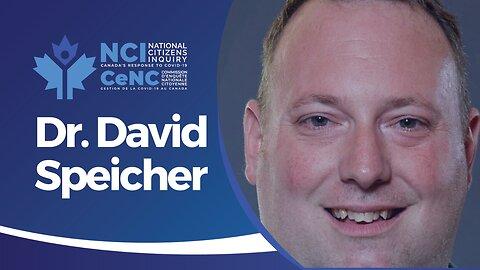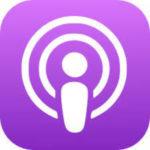Dr. David Speicher is an expert in coronavirus virology and diagnostics. Much fear during the pandemic was perpetuated by the assumption the asymptomatic were ill. Dr. Speicher commented, “If you are asymptomatic, you could pass on things and make other people sick and “kill Grandma.” And this is highly unlikely.”
* The above video is being streamed via Rumble. Check back often as we continue to update the complete list of links to all witness testimonies in both video and audio/podcast formats.
[00:00:00]
Wayne Lenhardt
Welcome back to the National Citizen Inquiry. My name is Wayne Lenhart, and our next person to testify is David Speicher. David, can you hear me?
Dr. David Speicher
Yes.
Wayne Lenhardt
I can hear you. I believe you have some slides set up with AV here. So I’ll just quickly introduce you, and then you can launch into your presentation [exhibit number unavailable]. You did your university, I believe, in Ontario. You have a PhD from McMaster.
Dr. David Speicher
No. No, I do not.
Wayne Lenhardt
Okay, you have a doctorate from somewhere. Can you tell me where that is, please?
Dr. David Speicher
I will launch into my slides, if can you see them?
Wayne Lenhardt
We’ve got your first slide. But before we do that, could you spell your full name for me and then I’ll do an oath with you.
Dr. David Speicher
Dr. David Jeremiah Speicher, it is D-A-V-I-D S-P-E-I-C-H-E-R.
Wayne Lenhardt
Do you promise that the testimony you’ll give today will be the truth, the whole truth, and nothing but the truth?
Dr. David Speicher
Yes, it is.
Wayne Lenhardt
Thank you. I see from your slide there, you’re a visiting professor of health science at Redeemer University in Ontario, and I believe you have a position at McMaster as well.
Dr. David Speicher
No, I used to. So if I can go to my next slide.
Wayne Lenhardt
There it is.
Dr. David Speicher
My undergrad is in biology at Redeemer. I have stuttered my whole life. It gets worse when I’m tested up. And that is okay. I know my things well. I have a Master’s in Diagnostics of Coronaviruses, and a PhD in Viral Diagnostics, both of which are from Griffith University in Queensland, Australia. I have worked in Kenya, India, Australia, Egypt, and here in Canada. I’ve done two post-doctoral fellowships at McMaster University, in molecular microbiology and in epidemiology.
I have run as a lab director two COVID-testing labs during the pandemic, doing between 5 and 15 thousand PCR tests per week, all on asymptomatic transmission. I have taught at Redeemer University since last fall in the courses of microbiology, genetics,
[00:05:00]
and PCR testing. I am now a visiting prof here in a paid job. And to disclaim: I am a co-applicant on a new SSHRC [Social Sciences and Humanities Research Council] grant a few months ago.
All of these are all scientific observations I have made during the pandemic. And I have 34 publications. Most, if not all, use PCR. And I have co-authored a method paper with the Wuhan Institute of Virology on [Whole-Genome Sequencing of Pathogens in Saliva].
Would you like me to keep going and dive into my thing or just my background?
Wayne Lenhardt
I think you are very well equipped to deal in this area, Dr. Speicher. I wonder if perhaps you could go to your slides relating to PCR testing, and maybe we’ll have a look at that.
Dr. David Speicher
Sure. I’d like to say, too: I worked on the team that first isolated the virus. I was removed off the team before I could see things. A FOI [Freedom of Information] request has shown that McMaster records has found no responsive records about isolates of this virus apart from this published paper. So, it begs the question: either there’s scientific misinformation going on or something isn’t right at [inaudible: 00:08:16] FOI.
There’s been millions in Gates funding poured into McMaster. Millions, including their new NEXUS pandemic hub for $12 million given to McMaster by Bill Gates to look into COVID-related issues.
There is also a potential conflict of interest. One of their profs in the field of ethics and policy for innovation on their NEXUS hub—before the pandemic—was paid $278,000. In 2021, this jumped up
[00:10:00]
to $623,000 and last year $461,000. She has ties with Bill Gates and the WHO. So are these people funding our [inaudible: 00:10:27]? Absolutely, they are.
I work on PCR. I love it. It’s a very elegant, super test. However, it cannot tell us if we are sick. It can just tell us—is this DNA or RNA sample sequence in my sample? And that’s it. Is this viral RNA in my sample? And so a lot of people on our side, I’ve heard things said: “PCR assays are 97 per cent false positive. It should not be used.” Well, let’s not throw the baby out with the bath water.
So all of this occurred in the first paper looking at Sars-CoV-2 by PCR. It was poorly designed and improperly validated and made. Well, my team put out this. And the main point is the bottom line here: “If someone tested positive by PCR at a threshold above 35 cycles, the probability that said person is actually infected is about 3 per cent.”
Why is it 35 cycles? If we go beyond that, it does not work. This is the limit of the detection of the amplification. On the left is right out of the Seegene package insert. These are for E gene, RdRP gene, and the N. These are highly conservative rates [inaudible: 00:13:42]. It says below on the left: a positive is anything before 40 cycles. If we look on the right—this is all my own data—and it shows the cutoff limit of the test is 37 cycles.
And therefore, we can’t tell. And [inaudible: 00:14:27], the lower Cts cannot be compared between labs. It’s all dependent on when the sample is tested, which swab, the hour things are extracted, amplified, and looked at. And so, a cycle between institutions
[00:15:00]
varies sometimes two or three, sometimes five cycles, and this is why [inaudible: 00:15:16] lab never report these to a physician. So a Ct value might change, except a positive in one lab should be a positive in another lab. So Public Health Ontario put out a report in September of 2020, and said, on the left, any amplification that occurs before 37 cycles is a true positive. If it’s between 38 and 40, it needs to be retested.
In my lab, on the right-hand side, this is what we did—if it’s two or three before 37, things are positive. And key values are never given out to a physician. We need a better link-up between a physician and the clinical lab, and, too, a PCR assay, most times, if it is a true positive with symptoms amplified before 30 cycles. And, therefore, I think we should have had two cut-offs: One between 35 and 37, which is the assay limit of detection—”Is this virus in my sample or not?” And then at about 30—“Is this individual infected or not?”
So if we look at PCR versus a RATs [Rapid Antigen Test]: Is this thing actually replication incompetent? The PCR is very, very sensitive, although it doesn’t tell—is this replication competent? Or is it replication incompetent and, therefore, is not in fact infected? And so we needed to not run things basically off of a single PCR test.
Now, how were our samples worked out? Well, most people drove, in a big line-up, to a collection facility,
[00:20:00]
and they had a nasopharyngeal swab rammed right to the back of their nose. Is this the best test? Sure, it’s the gold standard. But if you are sick with symptoms, a simple mid-turb [mid-turbinate nasal swab, MTS] right in here, works just as well.
If you look at the lower right, if you’re doing a nasopharyngeal, it’s going right in the back: it is 97, 98 per cent. But a mid-swab is about 87 [per cent], which is just as good as an oral swab of the mouth. And so why didn’t we swab people’s mouth, swab inside their nose, and not ram things right to the back? And then in some instances [inaudible: 00:21:40]
This is a case-demic. It’s not a pandemic of all sick individuals. We need to work out: Is this individual infected at a low level and has no symptoms? Or do they have a high enough viral load to infect other people?
And if you are infectious, most times you have symptoms. These are all numbers of people with COVID. COVID is a disease, and therefore, you must have symptoms. Except most of these—and all of these case counts—are off of a PCR positive test where the individual is either asymptomatic or with symptoms. Those things were not differentiated at all. And so, this is not just sick folks: these are sick people carrying the virion and those who are not sick.
We’ve all heard of HPV, which is the cause of cervical cancer. HPV is found easily on your forehead, on your hands, on your skin. Unless it infects your cervical cells, it will not cause harm. Therefore, I don’t care if you are infected or if you have it and don’t have symptoms. You need to be sick with a high enough load to pass on things to make other people sick.
This brought up the whole thing of asymptomatic transmission. If you are asymptomatic, you could pass on things and make other people sick and “kill Grandma.” And this is highly unlikely.
[00:25:00]
An infectious dose is between 500 and 2000 replication competent virion, which is around a Ct of 24 to 27. Therefore, we must have two cut-offs: one at the 35, which is at the limit of detection; and one at 30—is this [inaudible: 00:25:44] high enough to cause someone else to get sick?
The viral load always jumps up within two days before the symptoms, then comes back down around day six to eight. An individual can be PCR-positive 90 days post-symptoms. This is all non-infectious, non-replication competent virion being sent out of the system.
Therefore, asymptomatic transmission is rare. And if you are sick, you don’t lock down an entire city. If you are sick, stay home. It’s that simple.
Last point: rapid antigen tests. We’ve all seen them; we’ve all done them. You stuff these in, you add the stuff, wait 15 minutes. If you don’t do it right, if you don’t add enough stuff, or if you add too much sample, if you don’t add any stuff first: these here will give a false positive test.
And Public Health knew this. We were all informed. These are a cheap, quick screening tool. They are about $16 per test. A PCR test is between $50 and $100 per sample. However, a rapid antigen test has a limit of detection of about 1 million viral copies, and that’s it. One million, which is around a PCR cycle between 25 and 21.
Therefore, you will develop symptoms before these here turn positive, except for Delta. And therefore, a RAT test should never have been used on people which are asymptomatic and only in people with symptoms. A RAT is a presumptive test, and any positive test must be confirmed by PCR.
Now, last point. We have wasted millions on PCR testing
[00:30:00]
of people which were asymptomatic. These should only have been used on people with symptoms. There’s been five or six non-health care providers that have set them up and most of those are now shut after the PCR has been pulled. They did between 5,000 and 15,000 tests per week and charged between 50 and 100 bucks per test. You can work out the math on how much they made.
And so they are now folded. Most of those said, “Oh, we’ll do asymptomatic testing to take things off of our main hospital labs.” They made millions.
As soon as PCRs ended, they were pulled. There were five Thermo Amplitude systems set up across Ontario in our government labs. They were about $500,000 per system and can just run a full plate of 384 samples per plate, 10,000 bucks per run. And if someone messed something up and you had to repeat the whole thing, you’ve just wasted $10,000 of taxpayers’ money.
Most of these systems have not been used since April of last year, April 2022. And there are thousands of expired reagents sitting on shelves, all purchased by taxpayer funding.
Therefore:
Bill Gates has infiltrated most of our institutions to push these vaccines.
The PCR is an elegant, sensitive lab technique when it is used right and not to inflate numbers of asymptomatic folks with COVID when they aren’t actually sick.
We don’t need a nasal pharyngeal swab if a mid [MTS] or an oral swab will suffice.
It’s not a high-cycle count thing, which I’ve heard some folks say. Any sample beyond 35 cycles should not be called as a positive test ever.
We need more relations between a clinical lab and bedside to work out if they are “infected” or if they are “infectious,” and not to rely just on the PCR test for our numbers to represent a pandemic.
And a PCR and a RAT
[00:35:00]
should only have been used ever in people with symptoms.
That is all I have. And I am more than happy to answer any questions from anyone, ever.
Wayne Lenhardt
Are there any questions from the commissioners? Yeah, Dr. Massie.
Dr. David Speicher
Dr. Massie.
Commissioner Massie
Thank you, Dr. Speicher, for your presentation. I have a couple of quick questions. First one is about the comparison between the rapid antigenic tests and the PCR.
It was argued by some people doing, I would say, monitoring of the epidemiology that, although the PCR test was more sensitive than the rapid antigenic test, the advantage of the rapid antigenic test is that you would get the answer immediately instead of waiting for whatever—sometimes it was days, depending on the system you were relying on. And it would give you the answer: Am I infectious now? Versus, am I potentially infectious, and I would get the answer by the time, I don’t know, I’m isolated or I risk contaminating other people?
So for the management of this kind of— If one assumed that any contamination has to be avoided at all costs, which is a different topic altogether, having a rapid response to tell the people, “Okay, you have symptoms; you seem to have the virus because we can detect the antibody. You can self-isolate for a couple of days and wait until you’re no longer infectious.”
So why is it that this has not been more readily implemented? Because I don’t think that the delay between the time the PCR was available and the rapid antigenic test was made public to people was that significant in terms— So why is it that we have not proposed this approach instead of the massive PCR testing?
Dr. David Speicher
What is your question simplified, Dr. Massie?
Commissioner Massie
What I’m asking you is—were we technically limited in the deployment of the rapid antigenic tests? And that would explain why it took so long before we had them available? To my knowledge in Canada, I don’t think we’ve seen cases where the monitoring of the waves of infection was relying on this method versus the PCR. The PCR had always been the gold standard to monitor the number of cases.
Dr. David Speicher
It is the gold standard. And you’re right there. A PCR test is made faster; it’s much more easy to make and to use. Our first tests were deployed around late March, most of which are lab-developed tests. I think, though, that if we are looking at infectious loads, a rapid test is actually better. Because if you are sick and you have a high enough load, you will get a positive test. But if you are before symptoms when it’s low and you are post-symptoms, you’re not going to get a positive test. And so, there is a very short step, a shortened
[00:40:00]
window of about five days when they are actually useful. And that’s it.
Commissioner Massie
My other question has to do with following of the different way that we always focus on cases based on PCR positivity. If we’re not arguing at this point about the threshold that has been established and not well, I would say, at least, communicated—sometimes it was higher; sometimes it was lower, we didn’t know. But my point is: If you want to look at historical data since the beginning of the pandemic up to now, why is it that we don’t see more frequently what I would call the positivity rate, which is how many positive cases you get per number of people you’ve tested? Because if you want to compare whether you are in a very big wave or small wave, you could be misled by the number of tests you’re doing. So why is it that this was not implemented from the get-go?
Dr. David Speicher
It should have been. I talked early on with a colleague and I’m like, “Why are we calling all of these ‘COVID-positive tests’ and not a ‘SARS-2 positive test?’ One has symptoms and one doesn’t.” It was all because “COVID” would make things easier. And I’m sure it also inflated the count from a lab. All we receive is a tube with a name, date of collection, birth date, and that’s it. There’s no vaccine status; there’s no symptoms. And all we give back is a positive or a negative result. And that’s it. And so, it could be a positive with symptoms or without. On a lab end, we have no idea at all. That is all the physicians.
Commissioner Massie
Thank you very much. Thank you for your answer.
Commissioner Kaikkonen
I have more of a comment. I just want to applaud you in speaking or confronting the stereotypes that go along with stuttering. You did a great job and you’re certainly a prime example of someone who pursued education and stands as an equal. Thank you for your testimony.
Dr. David Speicher
Just for the record, I thank you for that. I have now lost five jobs during the pandemic because of my stance on things. So you just have to keep fighting and keep to the scientific facts, that’s it.
Wayne Lenhardt
Are there any other questions from the Commissioners? No.
Dr. Speicher, I want to thank you very much for your testimony today on behalf of the National Citizens Inquiry. Thank you for coming.
Dr. David Speicher
Thank you so much. Thank you.
[00:44:35]
Final Review and Approval: Margaret Phillips, September 6, 2023.
The evidence offered in this transcript is a true and faithful record of witness testimony given during the National Citizens Inquiry (NCI) hearings. The transcript was prepared by members of a team of volunteers using an “intelligent verbatim” transcription method.
For further information on the transcription process, method, and team, see the NCI website:
About these Transcripts
Credentials
- Master’s in Diagnostics of Coronaviruses
- PhD in Viral Diagnostics, both of which are from Griffith University in Queensland, Australia
- Two post-doctoral fellowships at McMaster University, in molecular microbiology and in epidemiology.
Summary
Dr. David Speicher presents his testimony as an expert in virology and states, “All of these are all scientific observations I have made during the pandemic. And I have 34 publications. Most, if not all, use PCR. And I have co-authored a method paper with the Wuhan Institute of Virology on [Whole-Genome Sequencing of Pathogens in Saliva].
Dr. Speicher explains about the much maligned PCR test, “I work on PCR. I love it. It’s a very elegant, super test. However, it cannot tell us if we are sick. It can just tell us—is this DNA or RNA sample sequence in my sample? And that’s it.” He continues, “the bottom line here: “If someone tested positive by PCR at a threshold above 35 cycles, the probability that said person is actually infected is about 3 per cent.”
McMaster University, and in particular one of the professors in the field of ethics and policy for innovation on their NEXUS hub—before the pandemic—was paid $278,000 from Gates funding and it has increased since then. There is absolutely a conflict of interest there Dr. Speicher said.
Some closing points from Dr. Speicher: Millions of dollars have been wasted on PCR testing of the asymptomatic; Bill Gates has infiltrated most of our institutions to push these vaccines; any sample from a PCR test beyond 35 cycles should not be called as a positive test ever.






















